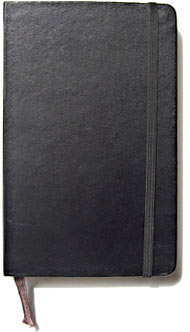 When I checked the links in the "Sketchers on the Web" section of the Sketching Forum I was amazed at how many photos of Moleskines I saw. A lot of artists swear by these little notebooks, and others are annoyed at all the hype surrounding them and their cult status. Several blogs and websites are dedicated to the Moleskine. When I checked the links in the "Sketchers on the Web" section of the Sketching Forum I was amazed at how many photos of Moleskines I saw. A lot of artists swear by these little notebooks, and others are annoyed at all the hype surrounding them and their cult status. Several blogs and websites are dedicated to the Moleskine.
So what's all the fuss about Moleskines? And just what is a Moleskine?
A Moleskine (pronounced mo-leh-skeen'-eh) is a small pocket size blank book with a black textured oilcloth cover which resembles leather, a permanently attached ribbon bookmark, a pocket on the inside back cover and elastic band to hold the cover closed when not in use. Moleskine pages are stitch bound, and this allows them to lie flat when open.
Well, that was the definition of a Moleskine back when they first appeared on the market in the late 1990's. The most recent descriptions talk about the "Moleskine brand" which covers all kinds of products such writing instruments, bags, computer cases, booklights and glasses.
I'm going to ignore that newer, expanded definition; as far as I'm concerned a Moleskine is still a small black notebook, and that is what this article is about.
One reason for the Moleskine's surge in popularity is the "art journal" boom which was helped by people such as Danny Gregory who has written several books including Everyday Matters . People who hadn't considered themselves artists suddenly discovered they could find great fulfillment through drawing and journaling. Gregory's book An Illustrated Life: Drawing Inspiration from the Private Sketchbooks of Artists, Illustrators and Designers . People who hadn't considered themselves artists suddenly discovered they could find great fulfillment through drawing and journaling. Gregory's book An Illustrated Life: Drawing Inspiration from the Private Sketchbooks of Artists, Illustrators and Designers shows how closely the Moleskine is associated with this phenomenon. shows how closely the Moleskine is associated with this phenomenon.
This article is written for "pocket sketchers" who like to carry a small sketchbook in the back pocket, ready to sketch at a moment's notice.
My preferred sketching media are pretty much limited to ink and watercolor and sometimes pencil, and I'm very picky about my sketchbook, and I write from that perspective.
The appearance, exit and reappearance of the Moleskine
The Moleskine notebook is based on a style of blank book which was originally produced by several manufacturers.
These blank books were known in France as les carnets moleskines which is translated moleskine notebooks in English.
The word moleskine means imitation leather in French, so no moles were skinned to make the notebooks.
Most of what we know about the original moleskine notebooks -- including their French name -- comes from a description by writer Bruce Chatwin in his book The Songlines which was published in 1987. If you want to read everything he wrote about the Moleskine Notebooks, you'll have to get the book,
which was published in 1987. If you want to read everything he wrote about the Moleskine Notebooks, you'll have to get the book, but here are are a few excerpts: but here are are a few excerpts:
In France, these notebooks are known as carnets moleskines: 'moleskine', in this case, being its black oilcloth binding. Each time I went to Paris, I would buy fresh supply from a papeterie in the Rue de l'Ancienne Comedie.
The pages were squared and the end papers held in place with an elastic band. I had numbered them in series. I wrote my name and address on the front page, offering a reward to the finder. To lose a passport was the least of one's worries: to lose a notebook was a catastrophe.
...
Some months before I left for Australia, the owner of the papeterie said that the vrai moleskine was getting harder and harder to get. There was one supplier: a small family business in Tours. They were very slow in answering letters.
"I'd like to order a hundred," I said to Madame. "A hundred will last me a lifetime."
She promised to telephone Tours at once, that afternoon.
...
At five, I kept my appointment with Madame. The manufacturer had died. His heirs had sold the business. She removed her spectacles and, almost with an air of mourning, said, "Le vrai moleskine n'est plus."
In English Le vrai moleskine n'est plus comes out "The true moleskine is no more".
The last Moleskine manufacturer did indeed cease operations in the mid 1980s and Les carnets moleskines became extinct.
They had been gone for about ten years when Italian manufacturer Modo & Modo brought them back to life and registered the name Moleskine as a trademark in 1996. About a decade after that, Modo & Modo could no longer handle the international demand for their product and was purchased by a larger company who changed the company's name to ... Moleskine.
Moleskines today
The current Moleskine notebooks are based on the original les carnets moleskines, and the cover is made of black oilcloth like the original.
These feel classy and are less conspicuous than a big spiral bound sketchbook when sketching around people since they will most likely assume you are just reading a book or making journal or calendar entries. A lot of artists love the sewn bound book format because it is so gratifying to draw in a book, and very satisfying to store them later on a book shelf. It's perfect for sketch journaling.
Of course, sketchbooks in real book form, even black ones, have been around for a long time. The Moleskine has an advantage over many other hardbound journals and notebooks because it is more slim and very portable. Its small size makes it the perfect traveling companion for the pocket sketcher. It will actually fit in your back pocket.
A spiral bound pocket notebook will also fit nicely into the back pocket, but with a Moleskine there are no wires to catch on your pants every time you bring it out, and no danger of pages falling out.
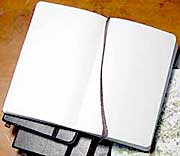 Now you can carry a classy sketchook with you everywhere, which means unplanned sketching may happen in your daily life more often. You can become the sketch hunter as Robert Henri described: Now you can carry a classy sketchook with you everywhere, which means unplanned sketching may happen in your daily life more often. You can become the sketch hunter as Robert Henri described:
The sketch hunter moves through life as he finds it,
not passing negligently the things he loves,
but stopping to know them,
and to note them down
in the shorthand of his sketchbook.
A pocket sketch hunter! The Moleskine makes it possible.
Most importantly, the Moleskine pages really do lie flat when open, which I think is their biggest selling point. It's much easier to draw on a flat surface and not have to battle with an uncooperative sketchbook.
The Moleskine line was expanded to include a variety of formats including notebooks, sketchbooks, address books, weekly planners, musical notation books, and story board books.
They even offer them in a larger version. As a matter of fact, now there are even larger "Folio" versions in A4 and A3 size (A3 is 12 X 16 1/2 inches or 42 X 29.7 centimeters, and this size doubles when the book is open).
Of course, every increase in size is also a step away from that slim pocket size format that made the original carnets moleskines so attractive as traveling companions in the first place.
There's also an accordion style Japanese Album notebook which is based on those long horizontal scrolls that can be seen in Japanese museums. I have never tried one, and can't comment on them. Ironic I suppose since I live in Japan.
Let's take a look at a few of these formats which are likely to be used for sketching, namely the Notebook, Sketchbook, and Watercolor Album:
Moleskine Notebooks
 These are good for general sketching with pencil or ink. They come in ruled, unruled, and grid ruled versions. If you are primarily drawing rather than writing, you will probably choose the plain (unruled) version which is identified by a light green paper band. These are good for general sketching with pencil or ink. They come in ruled, unruled, and grid ruled versions. If you are primarily drawing rather than writing, you will probably choose the plain (unruled) version which is identified by a light green paper band.
If you sketch with pencil or ballpoint pen or even a pigment pen such as the popular Microns , then you will have no problem with any of the three Moleskines I describe here. If you sketch with a fountain pen and ink, you may or may not have positive results with the notebook, depending on the ink you use. , then you will have no problem with any of the three Moleskines I describe here. If you sketch with a fountain pen and ink, you may or may not have positive results with the notebook, depending on the ink you use.
There are several fountain pen inks which work well on regular Moleskine notebook paper. For writing notes, I've found Platinum black ink and blue black ink work very well while their Carbon ink bleeds through. Noodlers black works very well, and it becomes waterproof when dry. I haven't tried Noodlers' other colors.
I'm sure there are many brands of ink that work well, but you will have to experiment a little to find them (I reserve the last page or so in my notebooks for ink tests). It helps if you use a fountain pen that's a bit of a dry writer, or one with a fine or extra fine nib.
I've filled several Moleskine notebooks with written notes using fountain pens and have had no problems at all. If you can find an ink converter for your fountain pen then you will have the freedom to try different brands of ink.
But this article is primarily about sketching in a Moleskine and not just writing notes.
The paper in the regular Moleskine notebooks is fairly thin and ink drawings can be seen on the other side, so you may want to just draw on the right hand pages when using ink. You can save the left hand pages for notes (done preferably in light pencil).
The notebook also comes in slim versions called Volant and Cahier, which fit in the pocket without bulging.
Moleskine Sketchbooks
 The sketchbooks have heavy paper which takes pencil very well. It also takes pigment ink pens such as Microns The sketchbooks have heavy paper which takes pencil very well. It also takes pigment ink pens such as Microns very well. It will take some fountain pen inks well, but some will bead up a little. The sketchbooks are horrible with watercolor. very well. It will take some fountain pen inks well, but some will bead up a little. The sketchbooks are horrible with watercolor.
Watercolor beads up on the sketchbook paper. Then if you rub it a bit with a brush it settles down. It's still unpredictable and hard to control, but some artists might actually like the effects it gets. One way around this is to use watercolor pencils (the sketchbook was created with pencil in mind after all). Here are the results of an experiment:
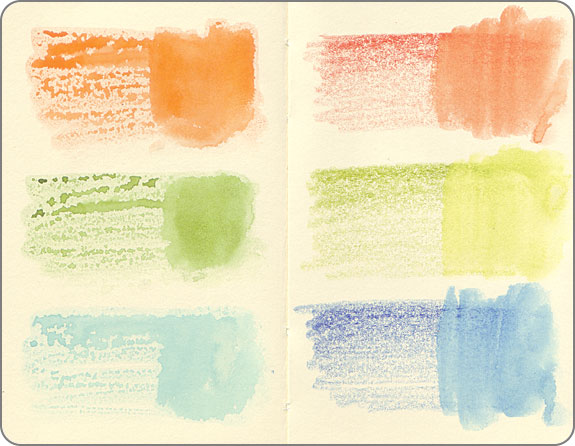 On the left page I brushed on Winsor Newton watercolors with a waterbrush. On the right half of these swashes I worked the watercolor into the paper by going over it with the waterbrush until it stopped beading. It took about 4 or 5 successive strokes before the color settled down. If you stroke too many times, the paper surface will start to break up, and you'll have new problems. On the right page I scribbled with Mitsubishi UNI watercolor pencils. I went over the right half of the swashes with water from the waterbrush . These only required 1 or 2 strokes to convert the pencil strokes to a smooth wash. You can see how the color from the watercolor pencils actually behaves well.
So many artists complained about this watercolor unfriendly paper that the manufacturer came out with a new Moleskine specifically for watercolor.
Moleskine Watercolor Album
 When I first wrote this article, these were called "Watercolour Notebooks" but apparently a few people questioned the odd name (I know I did) so they changed the name to "Moleskine Art Plus Watercolor Album" and gave it a new fancy paper band to replace the original plain pink band. I still don't know why they are reluctant to call it a sketchbook. When I first wrote this article, these were called "Watercolour Notebooks" but apparently a few people questioned the odd name (I know I did) so they changed the name to "Moleskine Art Plus Watercolor Album" and gave it a new fancy paper band to replace the original plain pink band. I still don't know why they are reluctant to call it a sketchbook.
There was great excitement and anticipation when this new addition to the lineup was first announced.
I had to wait a bit longer than many of my artist friends, since these products usually don't show up in Japan until several months after their debut in the west.
Like all Moleskines, the pages in the Watercolor Album lie flat when you spread them out, which as I have said is their best feature. The paper worked great with watercolors, and is much whiter than the notebook and sketchbook as you can see in the photo near the top of this article that has the different versions together.
The Watercolor Album also takes fountain pen ink very well as one would expect since it is intended for wet media.
So finally there was truly a Moleskine for watercolor sketchers if they didn't mind a few other issues, 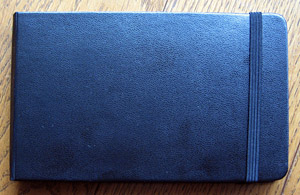 and there were mixed reviews about the Watercolour Notebooks (A.K.A. Watercolor Albums) soon after they came out. and there were mixed reviews about the Watercolour Notebooks (A.K.A. Watercolor Albums) soon after they came out.
One big issue which generated a lot of complaints in the various art forums was the perforated pages which made this version less "Moleskine-like" than its predecessors since the pages could now be easily torn out.
It appears that the company was listening, and the version with detachable pages was quickly retired, and replaced by the current non-perforated version.
You can tell by looking at the side of the paper even in the shrink wrap whether it is an older perforated version or the newer non-perforated version, although I think the perforated version has vanished from the market by now. These photos are from the non-perforated version.
Another big issue with the Watercolor Album was the format; they made it in a horizontal "landscape" format (binding along the short side).
Some people loved this, while others were disappointed that the maker didn't stick with the traditional vertical book format.
Most of my sketching has been done on location, standing or sitting on a stool while I hold the sketchbook in my left hand. So the horizontal landscape orientation is difficult to hold.
It's especially difficult to hold on a windy day. As I sketched the scene below, my hand cramped terribly from trying to keep the book balanced.
I have tried holding the book vertically like a reporter's notepad, but that's not any better as the unused part flips up and down, back and forth, throwing its weight around.
I contacted the Moleskine company more than once and begged them to consider making this watercolor sketchbook in a friendly vertical (portrait) format. But they did not respond.
From the various art discussion groups, I could see that many other artists had also contacted the company with the same complaint or request, but apparently the Moleskine company was no longer listening. Perhaps the sales of the expanded Moleskine brand product line were so good by this time, that they no longer felt the need to listen to the art community. But this opened the door for other companies to try and fill the gap with their own vertical sketchbooks, as I will describe below.
So I gave up on having a nice vertical Moleskine watercolor sketchbook. After some experimenting, I found a new way to hold this horizontal sketchbook which might make it less awkward to use.
You cradle it in your hand and rest it on your arm (I wrote right arm but I meant left!). This works with the small and large Moleskine. You'll need a clip in the middle, and for both edges if the wind is blowing.
What about the larger horizontal Moleskine Watercolor Album ? I went out and bought one so I could answer the question. The problem was even worse, and was not helped by my arm-cradle solution. ? I went out and bought one so I could answer the question. The problem was even worse, and was not helped by my arm-cradle solution.
But one positive aspect of this extreme horizontal format was that it changed the way I sketched -- now I was thinking detailed panoramas, and there are a lot of great panorama subjects which I had not considered in the past.
I bought this notebook in central Tokyo, and proceeded to try it out at the imperial palace grounds, the former castle of the shoguns, because I recalled there were some wide scenes around there that would suit this format well.
I have sketched this scene several times in the past, but this was the first time I was able to get the turret on the right, the gate in the background and the tower in the distance all on one page.
I could see how this larger sketchbook would be great for traveling and capturing more scenery in a single sketch.
 However, since this larger version is heavier and even more unbalanced and awkward than the pocket version, my hand was pretty sore after holding it for two and a half hours. However, since this larger version is heavier and even more unbalanced and awkward than the pocket version, my hand was pretty sore after holding it for two and a half hours.
After mulling over the problem later, I came up with another simple solution. I cut a plywood board the exact same size as the large Moleskine Watercolor Album.
This board was four millimeters thick, because that was what I happened to have at home.
Then I clipped it to the back of the Watercolor Album with most of the board behind the lighter half of the notebook, and only enough board to accommodate a clip under the heavy half.
Since this was a new notebook, the right side was heavy and most of the board was under the left side.
I tried it out on my next sketch, and it actually worked, and the heavy side was no longer flopping around trying to persuade the notebook to do a somersault.
Granted, the whole thing is still long and unwieldy, and my hand does get sore after sketching for a while when I'm standing, but at least I have a fighting chance now.
In the photos below, I'm holding the Moleskine on the lighter half with no major problem (except for a tired left hand).
After I struggled for many months with this awkward horizontal format, I finally stopped using the Moleskine Watercolor Album for on-the-spot ink sketches.
But I could still draw in this sketchbook -- at my desk where I don't have to balance it in my hands.
And I began to draw horizontal rows of people in this sketchbook because this format gives this type of subject greater impact than a vertical format.
This sketch was done with dip pen and ink in the horizontal Moleskine Watercolor Album . .
Proliferation of les carnets moleskines
When I first wrote this article, the Moleskine was the only game in town. In the years since those days, artists who didn't like the paper quality or the limited formats or the price or the advertising hype have taken to the blogs and discussion forums to discuss various contenders for the coveted title of "Moleskine Killer."
As I mentioned above, the original blank books were called les carnets moleskines and they were produced by several manufacturers until the last one went out of business in the mid 1980s.
Well, the good old days are back, and many manufacturers are once again making this type of pocket sized blank book, and the number continues to grow. We are all indebted to Modo & Modo (now called "Moleskine") for jump-starting this industry and pumping new life into it with all their marketing money.
As I mentioned above, the stationery shop owner told Bruce Chatwin in the 1980's, Le vrai moleskine n'est plus (The true moleskine is no more), which implies that there were authentic Moleskines as well as imitations at the time. That is also the case today, and one could argue that the Moleskine brand is the only true Moleskine even now.
Some Moleskine imitations are not worth considering because they are not stitch bound and do not lie flat when open. But there are a few "les carnets moleskines" that are just as good or better than the Moleskine brand, depending on your needs.
Many cost much less than a Moleskine, too.
There are several brands out there but I will only comment on ones I have personally tried.
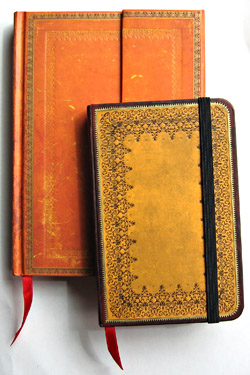 Paperblanks Paperblanks
I bought a few blank books called Paperblanks which take the concept of "artsy notebook" to a new level.
They come in an amazing variety of designs including references to famous artists and musicians.
Some have magnetic fasteners instead of the elastic band. They are very exciting, and will be loved by most artsy journalers.
But a book is more than just its cover.
Unfortunately the paper does not like most fountain pen inks, and feathers and bleeds terribly, much to my disappointment since I had bought three.
The good news is that two of my Paperblanks accepted Noodlers black ink in a fountain pen very well (that Noodlers is a miracle ink, and is sometimes the only ink that works on some papers -- it's also waterproof when dry).
I gave the third Paperblank to my daughter who does not use fountain pens. The two I kept for myself are in the photo. They look so cool...
The paper is regular notebook paper for writing and drawing but not for watercolors. Some of them are great for journaling with a fountain but don't even think about sketching with ink and watercolor in one of these.
The Paperblank's paper is similar to a Moleskine regular notebook but it is no replacement for a Moleskine Sketchbook or Watercolor Album.
Note: Several years after I wrote this, I heard that the Paperblanks Book Company eventually started using better paper in all of their notebooks which would accomodate fountain pen ink. But I have not bought a new Paperblank book to verify this.
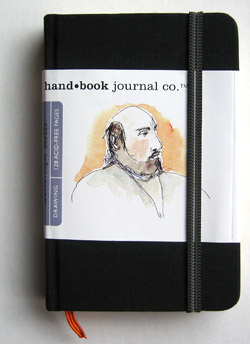 Hand Book Artist Journals
Hand Book Artist Journals
The label says hand book journal co., and a web search for this or Hand Book Artist Journals will turn up several internet vendors.
It is similar in appearance to a Moleskine sketchbook, and comes in two sizes like the Moleskine -- and three formats, landscape, portrait and square.
It also comes in four colors, black, blue, red and green.
The cover is fabric, which feels good, like a hardbound library book.
It's thicker than a Moleskine Watercolor Album (2 cm compared to 1.5 cm) so it won't easily fit into the back pocket -- which may kill spontaneous opportunities for the pocket sketcher.
But there are more than twice as many pages: 128 compared to 60 in the Moleskine.
It has heavy sketchbook paper, which is very nice, but it is not watercolor paper, which means you can use watercolor in it, but ambitious watercolor tricks might not come out as expected.
The surface can start to break up as it gets wet, leaving tiny specks of color in your washes.
For casual pencil or ink sketches with watercolor, this sketchbook is perfectly adequate.
The paper is heavy but can still buckle a little, but since it is in a book, it gets ironed out flat when it is closed. That's one great thing about hardbound sketchbooks.
In the sketches of subway passengers above, I used my standard sketching tool, a brush pen and fountain pen filled with Platinum carbon ink, and watercolors, either Winsor & Newton or Holbein. It worked okay with these tools and in this sketching style.
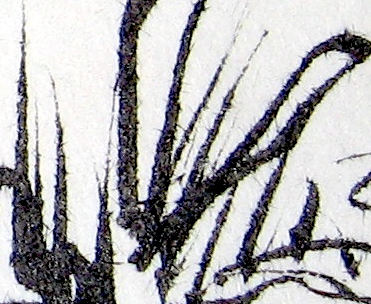
But by the time I reached the middle of the sketchbook, the paper quality was different, as you can see in the photo above and in the close-up on the right.
There was serious ink feathering on these pages to the extent I could no longer sketch in ink and had to switch to pencil.
Pigment ink pens such as Microns also work well in this book, since they make a fairly dry line. also work well in this book, since they make a fairly dry line.
I don't know if they used different paper halfway through the sketchbook, or if the passage of time somewhow degraded the quality.
Also, after several months all the pages started to yellow at the edges.
On the positive side, the paper is thick enough that you can barely see the image on the other side if at all, which means you can sketch double page spreads.
So if you sketch mainly in pencil or Microns with light watercolor washes and want a really fat economical sketchbook with lots of thick pages, then you will love these books and save lots of money. with light watercolor washes and want a really fat economical sketchbook with lots of thick pages, then you will love these books and save lots of money.
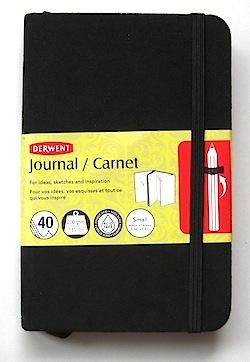 Derwent Journal Derwent Journal
I had read some good reviews on the web about the Derwent Journal and it seemed to be exactly what I was looking for, a slim pocket sized sketchbook in vertical format that has good paper suitable for ink and watercolor sketches.
I searched many art supply and stationery shops in Tokyo but could not find the Derwent Journal anywhere -- although Moleskines were prominently displayed in practically every shop I visited.
So I ordered the Derwent online and anticipated the revolutionary change it would bring to my sketching life.
When it arrived, I could see how similar it was to an Moleskine at least in general appearance.
I ordered mine from a vendor in Japan and was surprised to see it had a black elastic band which I had not seen in the photos on the web. So it looked even more like a Moleskine.
However, it was not as slim as a Moleskine, and was more bulky in the back pocket.
The "faux suede" cover acted as sort of a non-slip surface, which made it difficult to slide in and out of my pocket.
I suddenly came to appreciate the Moleskine's slick surface.
Then I tested the Derwent Journal with pencil, ink and watercolors. It works great with pencil as can be expected since Derwent is a pencil company.
But then again, I have never tried any sketch paper which doesn't at least accept pencil marks.
Microns also work well on this paper. It seems that any paper that takes pencil lines will also take Micron ink lines as well. I wish I could learn to love Microns also work well on this paper. It seems that any paper that takes pencil lines will also take Micron ink lines as well. I wish I could learn to love Microns , but for some reason I can't warm up to them. Like I said, I'm picky. , but for some reason I can't warm up to them. Like I said, I'm picky.
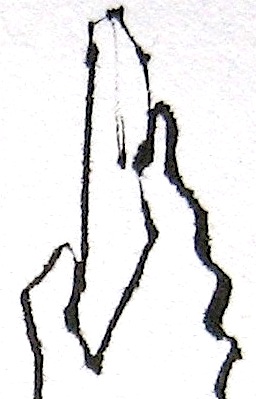 When I tried to make ink lines with Platinum carbon ink in a brush pen and also a fountain pen, the ink feathered a bit. When I tried to make ink lines with Platinum carbon ink in a brush pen and also a fountain pen, the ink feathered a bit.
The image to the right is a close up of the girl's hand holding a phone on the right hand page above.
The feathering was not as extreme and spidery as the Handbook, but still enough to be distracting, and possibly ruin an otherwise nice ink sketch.
It certainly did not measure up to the Moleskine Watercolor Album which had no feathering at all.
When I tried watercolor in this journal, the paper quickly absorbed the water and prevented me from blending color, which should be possible as long as the underlying wash is still moist.
In the sketch of the man on the left hand page, I had expected the darker blue strokes in the shirt to blend in to the lighter blue which I had just painted. However, it retained crisp edges to my disappointment.
The same thing happened in the face, where soft edges are preferred.
Also, after just the first pass of the brush the paper surface started to break up, leaving dark color-saturated flecks. This is clearly not watercolor paper.
If you sketch in pencil or Microns only, then you may like this journal. For quick ink and watercolor sketches, you may be disappointed. only, then you may like this journal. For quick ink and watercolor sketches, you may be disappointed.
Again, the problem is not as pronounced as in the Handbook Artist Journal, and you might be able to tolerate it, but it isn't as nice as the paper in the Moleskine Watercolor Album.
On the positive side, I loved the bright white paper, which is even whiter and brighter than the Moleskine Watercolor Album, and one reason to try to learn to love the Derwent Jorunal. The other reasons being its vertical format and cheaper price.
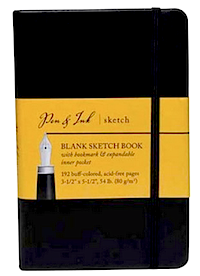 Pen & Ink Sketch Book Pen & Ink Sketch Book
A few months ago I bought a Pen & Ink Heavy-Weight Blank Sketch Book by Art Alternatives, which is the perfect pocket size at 3.5 x 5.5 Inches.
I had high hopes for this one since it was apparently produced specifically for pen and ink, and had gotten great reviews on the internet. It looks just like a Moleskine and feels a bit nicer, and the paper is very smooth.
With great anticipation, I sat down at my desk and drew one figure with my brush pen filled with Platinum Carbon Ink. Unfortunately the ink feathered just enough that I can't use it!
So I reluctantly retired this sketchbook after drawing just one page. I can't take a photo of that failed sketch now because apparently I tore it out and threw it in the trash.
I think I was more disappointed with this one than the others because the title and the reviews had me convinced that I had found my perfect sketchbook.
As with the other brands mentioned above, this takes Microns and pencil very well. As a matter of fact, the smooth paper allows you to use some great pencil techniques.
This paper also works well with a dip pen and thicker drawing ink such as india ink and thicker drawing ink such as india ink or Japanese Sumi or Japanese Sumi or manga ink or manga ink . I think the same could be said for the other sketchbooks above which made my carbon ink feather, because carbon ink was formulated to flow smoothly in fountain pen ink channels. . I think the same could be said for the other sketchbooks above which made my carbon ink feather, because carbon ink was formulated to flow smoothly in fountain pen ink channels.
But this article focuses on pocket sketchbooks for on-the-spot sketching in ink and watercolor. If you draw in ink at your desk or are ambitious enough to sketch on location with a brush or dip pen and a bottle of ink, then you might want to try this sketchbook.
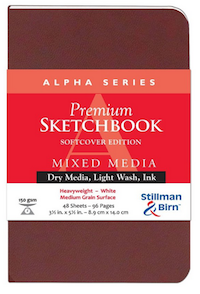   Stillman and Birn Stillman and Birn
Stillman and Birn has produced a line of sketchbooks which have been receiving a lot of attention.
I was surprised to discover that so many members of the Sketching Forum are singing the praises of Stillman and Birn Sketchbooks.
It is a company who focuses on the needs of artists and has listened to their gripes and suggestions. As a matter of fact, they interact with customers on their Facebook page.
They have produced exactly what artists are demanding; vertical as well as horizontal sketchbooks in both hardbound and softcover versions, and in a variety of sizes from a huge 11 X 14 inch sketchbook all the way down to 3.5 X 5.5 inches which is perfect for us pocket sketchers.
And their sketchbooks come in a variety of quality watercolor paper based on artists' preferences.
The different types of paper in these sketchbooks are identified by Greek letters: Alpha, Beta, Gamma, Delta, Epsilon and Zeta (the English equivalents would be A,B,G,D,E and Z).
 |
Alpha and Beta have white paper. Alpha paper has an average sketchbook paper thickness, and Beta paper is really thick like what you might find on a watercolor block. |
 |
 |
 | Gamma and Delta have ivory colored paper with Gamma paper being average weight and Delta paper being really thick. |
 |
 |
 | Epsilon and Zeta paper is white and smooth but still with some texture, and is perfect for ink sketches with Epsilon paper being average weight and Zeta paper being really thick. |
 |
 |
 | Nova paper is toned paper for mixed media including ink and light wash. It comes in Black, Grey, or Beige (or all three in one book with their Nova Trio). Nova comes in an average weight the same as Alpha, Gamma and Epsilon. |
 |
All the papers are great with watercolor.
Well, Epsilon and Zeta and Nova will take watercolor washes just fine but nothing too ambitious.
For the most direct comparison with Moleskine watercolor paper in terms of paper color, weight and texture, Stillman and Birn's Alpha paper comes the closest, and I would say that it is actually better than Moleskine watercolor paper. One big difference is the texture; Stillman and Birn's Alpha paper has less texture (smoother and less bumpy) than Moleskine watercolor paper, so it's easier to draw fine ink lines.
In the sketch below done on Alpha paper, you can see in the shaded parts of the hands and in the jacket how the edges of the darker color are soft because the underlying color stayed moist as I had expected.
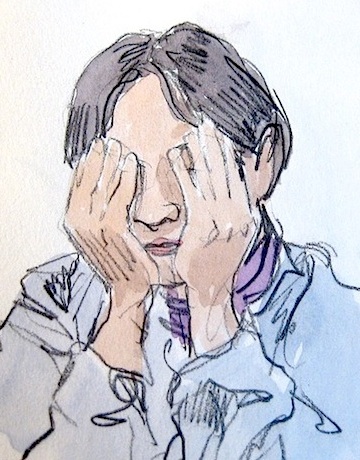 Quick pencil and watercolor sketch done in an Alpha sketchbook on the train
Quick pencil and watercolor sketch done in an Alpha sketchbook on the train |
Stillman and Birn's softcover sketchbooks are practically the same size as pocket Moleskines so their Alpha 3.5 X 5.5 inch softcover sketchbook  comes the closest to the pocket watercolor Moleskine Album -- and it is available in both horizontal and vertical formats. Finally, my dream has come true! comes the closest to the pocket watercolor Moleskine Album -- and it is available in both horizontal and vertical formats. Finally, my dream has come true!
And since their pocket size sketchbook is softcover and more slim, it fits much better in the back pocket than a Moleskine, and still looks every bit as classy as a hardbound book.
And if you want this with thicker paper, you can get the Beta.
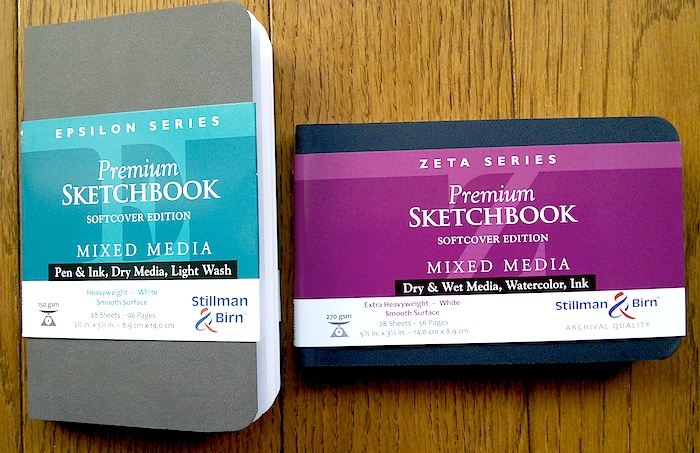
Two softcover pocket size sketchbooks: A vertical Epsilon and horizontal Zeta |
 |  Quick brush, pen and ink and watercolor sketch done in an Alpha sketchbook on the train
Quick brush, pen and ink and watercolor sketch done in an Alpha sketchbook on the train |
Stillman and Birn sketchbooks also take ink very well.
The sketch on the right which was done with a brush pen and fountain pen, both filled with Platinum Carbon ink, and later colored with a light watercolor wash, with some darker washes blended in.
There is no feathering (spidery lines) or bleeding (soaking through) of ink.
This is important since you can use both sides of the paper and fill your sketchbook with double page spreads if you like.
All the paper is thick enough that there is no ghost image on the reverse side, and that goes double for the heavy weight papers, Beta, Delta, and Zeta.
Stillman and Birn sketchbooks don't have a ribbon marker or elastic band or that pocket in the back.
But most artists never wanted those features in the first place.
These softcover sketchbooks come with color covers based on the paper type.
For those who must have a serious black sketchbook, Stillman and Birn also makes hardbound sketchbooks which have more of a family resemblence to those black hardbound artist sketchbooks which have been around forever. which have more of a family resemblence to those black hardbound artist sketchbooks which have been around forever.
Of their black hardbound sketchbooks, the closest one to the Moleskine pocket watercolor sketchbook would be the Alpha 4 X 6 inch sketchbook, which is slightly larger than their 3.5 X 5.5 softcover sketchbook, and doesn't have round corners. And, again, if you want thicker paper, you can go for the Beta.
One thing I have discovered about the softcover sketchbooks is that while they open perfectly flat, this also puts a strain on the covers which are naturally not as strong as the board in the hard covers. The end sheet can actually pull away from the cover.
But I have found a simple way to prevent that.
Open the new sketchbook slightly at the mid-point, and place it on a clean surface, pages facing down.
Then gently open the sketchbook by pressing it downward to flatten it while creasing the entire spine with a burnishing tool or your thumbnail so that a crease forms along the length of the spine. This will allow the book to lie perfectly flat and not cause any stress to the end sheets.
The "valley" in the spine in the center of the picture below is the creaae I put in with my thumbnail.
You'll be surprised how nice and flat the open sketchbook has become. Maybe Stillman and Birn will put such a crease in the spine some day. I wouldn't be surprised if they do, because they are always listening and responding!
As for paper types, since I draw in ink, I personally prefer pure white paper over ivory color, so I can see more sparkle between the hatch lines. So I use both the Alpha and Epsilon sketchbooks, and also have the heavy weight Beta and Zeta ready just in case I decide to go with heavier paper.
The smooth Epsilon (and Zeta) allows for a more crisp line that the Alpha (and Beta), but the difference is very subtle, and I usually can't tell the difference.
One advantage the Alpha seems to have over the Epsilon is that some inks soak into the paper better and don't smudge onto the facing page. For example, my Platinum Carbon ink will rub off a little when dry from Epsilon paper, but not Alpha paper.
Here are a few carefully rendered ink and watercolor drawings (not on-the-spot sketches) to show how nice both Epsilon and Alpha paper are with ink and watercolor.
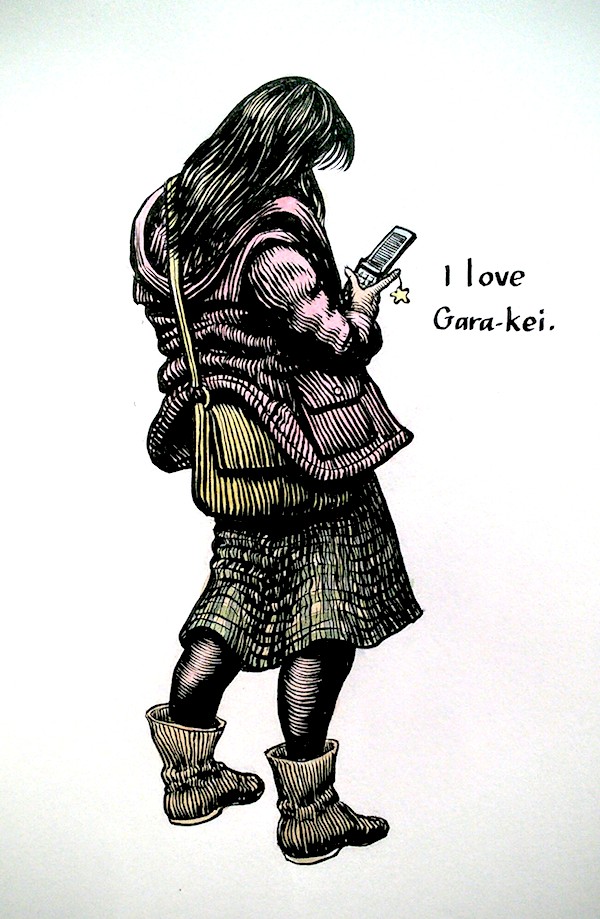
Carbon ink drawing on Epsilon paper (Gara-kei is Japanese slang for old type mobile phones) |
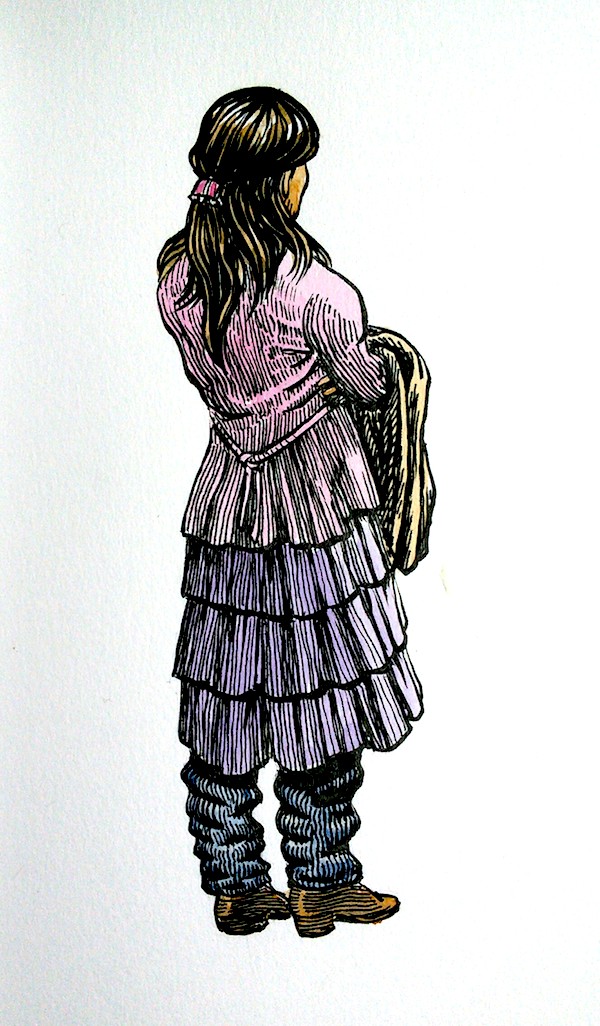
Carbon ink drawing on Alpha paper |
My Verdict
If you sketch primarily with pencils or pigment ink pens, then there are several great alternatives to the Moleskine which come in a variety of colors, shapes and prices. You can enjoy the portability of this small format and save yourself lots of money. No need to buy a Moleskine unless you just plain like them.
But going back to the title of this article, with all these choices today, is the Moleskine still the best pocket sketchbook out there? When I first wrote this article in 2004, the Moleskine was clearly the best pocket sketchbook available because it was practically the only pocket sketchbook that was not a wire-spiral bound type. And later when Moleskine produced a sketchbook with good watercolor paper, no other Moleskine imitators could come close.
For artists who like the Moleskine Watercolor Album's horizontal format, it is still a decent pocket sketchbook for watercolor -- although I have noticed the paper now isn't as ink friendly as it used to be.
For the best pocket sketchbook out there today I would have to include the twelve Stillman and Birn 3.5 X 5.5 inch softcover sketchbooks (Alpha, Beta, Gamma, Delta, Epsilon and Zeta in either vertical or horizontal format). Thanks to Stillman and Birn we now have a great selection of pocket sketchbooks which should satisfy every artist, even picky artists like me. They work well with all media, including my own favorites, ink and watercolor.
Every nice thing I have written above about the Moleskine Sketchbooks can also be said about the Stillman and Birn Sketchbooks, and they gave us so many options, including a soft cover so they fit better in the pocket!
So I would recommend that you try both Moleskine and Stillman and Birn, whichever version best suits your choice of medium. These are the best pocket sketchbooks available now.
(Some of the material for this article was taken from artices which appear in the Sketchbook of Russell Stutler.)
Here are Amazon links to products mentioned on this page:
Moleskine Classic Notebook
Moleskine Sketchbook
Moleskine Watercolor Album
Moleskine Watercolor Album, Large
Paperblanks
Hand Book Artist Journals
Derwent Journal
Pen & Ink Heavy-Weight Blank Sketch Book
Pen & Ink Notebook 5.5X3.5LS 
Stillman & Birn Alpha Sketchbook (white paper)
Stillman & Birn Gamma Sketchbook (ivory paper)
Stillman & Birn Alpha 3.5 X 5.5 inch softcover sketchbook 
Sakura Pigma Micron Pens
Speedball 2-Ounce India Ink, Super Black
Zig Cartoonist Highly Opaque Pen Ink, Sumi
Kuretake Manga Pen Ink - 60 ml Bottle - Black
G Model Chrome Pen Nib, Pack of 10
Dip Pen Set For Cartoonists and Artists
|